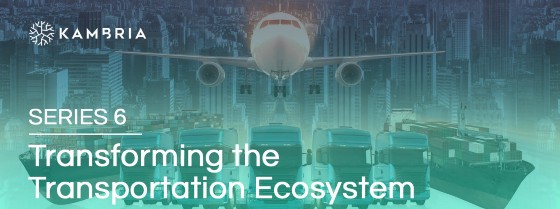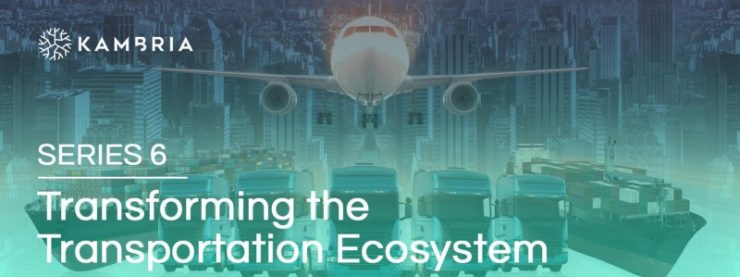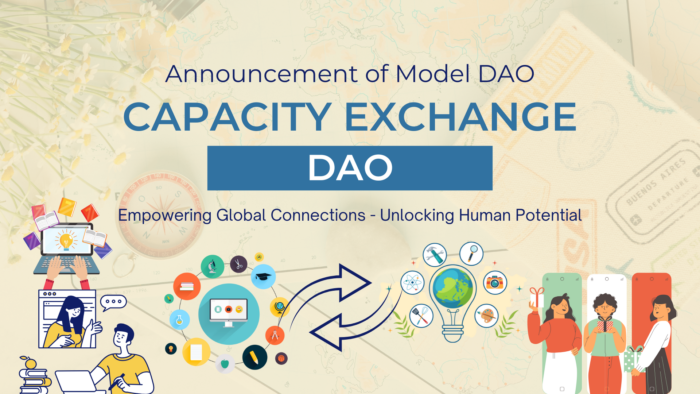
The transportation industry has yet to see any impactful advancements in technology for close to a century. This is primarily due to a lack of collaboration between researchers, consultants, companies, and industry vendors. These concerns coupled with high levels of isolation between organizations has slowed the adoption of frontier technology, which has contributed to the slowed growth in the transportation industry for years.
New technology in automation, sensors, and AI promises to solve transportation’s critical problems while simultaneously creating a more efficient and data-driven ecosystem. How will the adoption of frontier technology contribute to the reimagining of the movement of people and goods and how can Kambria speed up the process of adopting impactful technology?
Current Challenges in Transportation
Over 1.25 million traffic-related fatalities occur around the world each year (SOURCE: World Health Organization, “Number of Road Traffic Deaths,” data from 2013).
Although the world is evidently ready for change, the transportation industry is still riddled with problems that stifle its potential of becoming a modernized and efficient industry:
- Environmental pollution
- Capacity
- Lack of mass transit
- High crash risk
- Crumbling infrastructure
- Depleted or nonexistent dedicated transportation funds
- Lack of collaboration between agencies
Over 50% of the global population already live in cities, and that number is anticipated to grow to 70% over the next 40 years (SOURCE: The Guardian).
Public transportation has attempted to alleviate the traffic congestion in cities, but it is not as effective as the implementation of autonomous vehicles will be. AI will empower cities to better optimize their urban design, which will effectively ease congestion by using data and traffic control.
How Advanced Technology and Collaboration Will Transform Transportation
Smart technology can help address many transportation problems and evolve the industry as a whole. Massive breakthroughs in transportation-related AI technology are already occurring today, with autonomous vehicles surging in popularity around the globe. According to WinterGreen Research, over 90 million autonomous-capable consumer vehicles will be on the road by 2023. Kambria expects its platform to bring a healthy collaborative environment into the industry, which will stimulate innovation and speed adoption of frontier transportation technologies.
In the last 5 years alone, many transportation-related AI technologies have been rapidly gaining attention:
· Autonomous cars
· Driverless taxis
· Self-organization fleets
· Smart containers
· Smart Infrastructures
All major car manufacturers are currently exploring autonomous vehicles, with companies like Google and Lyft having autonomous fleets roam the streets of many cities. The Department of Transportation also recognizes the positive impact AI is making and has moved to create proposals for cities that are looking into smart infrastructures. It will award $40 million USD to a city that can demonstrate how to effectively solve critical municipal challenges using innovative transportation technologies, data, and applications.
There are several use-cases in which AI is planned to be used in transportation, these technologies will entirely change transportation forever:
· Autonomous Buses: Small-scale trials of autonomous buses have been initiated all over the world, most prominently in Finland, Singapore, and China. These buses will have the ability to plan more efficient trips for end-users, and fleets will experience less waste due to the data-driven technology they will use. Increased accessibility of public transportation to all members of a community will become a reality thanks to real-time travel schedules.
· Decentralized Traffic Flow: Rapid Flow technologies’ Surtrac system (developed by Carnegie Mellon University) has assisted in reducing travel times by more than 25% on average and reducing wait times by an average of 40% in an East Liberty neighborhood of Pittsburgh. This same technology can seemingly be applied to overly-congested cities with outstanding results.
· Smart Trains: GE Transportation is actively utilizing AI to develop intelligent locomotives in hopes to improve efficiency of rail transportation. Cities that are ahead of the curve have already implemented autonomous trains in their underground railway systems (Paris, London, and Shanghai).
· Self-Driving Trucks: Autonomous truck delivery is already being tested by companies like Uber and Budweiser. An autonomous Uber truck delivered 50,000 cans of Budweiser over 120 miles successfully. Just last year, Chinese company TuSimple secured $55 million in funding to bring its self-driving truck technology to the US. Their groundbreaking trucks have deep-learning AI and utilize long-distance sensors with a full observation range. Multiple cameras allow the trucks to detect and track objects around the vehicle (Source: Futurism). This technology is anticipated to improve road safety, lower costs, and reduce emissions compared to human-controlled trucks.
· Sustainable Intelligent Vehicles: In 2016, a company called Local Motors created an autonomous and self-sustaining vehicle they named Ollie. Ollie is driven by IBM’s Watson technology and is also fully electric, representing a new wave of smart and sustainable vehicles.
· Drone Air Taxis: In 2017, the world’s first test flight of the flying Autonomous Air Taxi (Volocopter) took place in Dubai. These air taxis could be the preferred transportation method of the future, as avoiding traffic conditions would be eliminated through their usage.
· Virtual Tracks: China launched ART (Autonomous Rail Rapid Transit) last year in the city of Zhuzhou. ART does not require tracks — it instead follows a virtual track made of painted dashed lines. This technology would revolutionize rail transportation while significantly cutting down the work that is required to create a railway.
With technology advancing at lightning speed each year, the impact of AI and other frontier technology on transportation will be multi-fold. It can help make people more productive and travel smarter; and revolutionize how we travel, drive and deliver. With an open-collaboration platform like Kambria, it is safe to assume that most of these innovative technologies will become mainstream sooner than anticipated.
Kambria’s Ambition for the Transportation Industry
Kambria has developed a platform where key players in the transportation industry can collaborate in ways previously impossible. Organizations will have the ability to share resources and research through Kambria, and since Kambria is built on the blockchain; any concerns about security of private data are effectively eliminated. Users of Kambria will be empowered to learn, collaborate, and educate each other about new AI transportation technologies and ideas.
Our hope is that our platform pushes the transportation industry forward by creating an environment that makes it easier than ever before to innovate together. Kambria is proud to deliver a platform that can remove the pins in AI adoption and speed up the process of innovation in the transportation industry by incentivizing collaboration. With proper implementation of technology in the transportation industry, traffic fatalities could be significantly reduced, and even potentially eliminated in the future. In other words, Vision Zero is attainable if we work together to develop and adopt smart technologies!
The Kambria Team
Website: https://kambria.io/
Whitepaper: https://kambria.io/Kambria_White_Paper_v2.pdf
Telegram (ENG): https://t.me/kambriaofficial
Telegram (KOR): https://t.me/KambriaKorea
Telegram (VIE): https://t.me/KambriaVietnam
Telegram Announcement Channel: https://t.me/kambria
Twitter: https://twitter.com/KambriaNetwork
Facebook: https://facebook.com/KambriaNetwork
Reddit: https://www.reddit.com/r/KambriaOfficial/
Email: info@kambria.io








